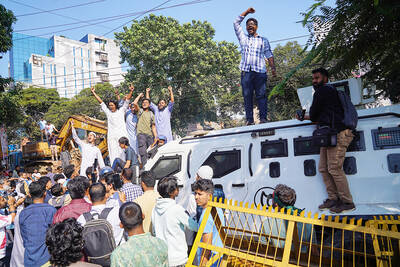On a trip to China next week to talk about high-stakes issues like terrorism and North Korea, US Vice President Dick Cheney will have another task -- making a pitch for Westinghouse's US nuclear power technology.
At stake could be billions of US dollars in business in coming years and thousands of US jobs.
The initial installment of four reactors, costing US$1.5 billion apiece, would also help narrow the huge US trade deficit with China.
China's latest economic plan anticipates more than doubling its electricity output by 2020 and the Chinese government, facing enormous air pollution problems, is looking to shift some of that away from coal-burning plants. Its plan calls for building as many as 32 large 1,000-megawatt reactors over the next 16 years.
No one has ordered a new reactor in the US in three decades and the next one, if it comes, is still years away. So China is being viewed by the US industry as a potential bonanza.
Cheney's three-day visit to Beijing and Shanghai next week is part of a week-long trip to Asia.
He will focus on terrorism and nuclear tensions over North Korea, but he also is expected to talk up US reactor technology, according to industry and government sources.
A senior administration official, briefing reporters about the trip, said Cheney will not "pitch individual commercial transactions." But he intends to make clear "we support the efforts of our American companies" and general access to China's markets, said the official, speaking on condition of anonymity.
Some critics are concerned about such technology transfers.
"This pitch could not be more poorly timed," Henry Sokolski, executive director of the Nonproliferation Policy Education Center, recently told a hearing of the House International Relations Committee.
Citing recent Chinese plans to help Pakistan build two large reactors that are capable of producing plutonium, he said it is not the time for China to be rewarded with new reactor technology. US officials said the Chinese have given adequate assurances that such sales will not pose a proliferation risk.
Bid solicitations for four new reactors are expected to be issued by the Chinese within months.
The leading competitors are US-based Westinghouse Electric and a French rival, Areva, which is peddling its next generation of reactors that are built by the company's Framatome subsidiary.
Westinghouse is putting its hopes on its 1,100-megawatt AP1000 reactor, an advanced design that is still awaiting approval from the Nuclear Regulatory Commission before it can be built in the US. Westinghouse, owned by the British nuclear firm BNFL, is the only US-based manufacturer of a pressurized water reactor, the type of design China has said it wants to pursue.
"Clearly the China market is very important to the industry and a supplier like Westinghouse," said Vaughn Gilbert, a spokesman for the Pittsburgh-based reactor vendor. "The Chinese market is one that we're pursuing."
Each of the AP1000 reactors are expected to cost about US$1.5 billion. "We would assume there would be more than one order," Gilbert said, since China has indicated it wants a standardized design across its reactor program. A successful bid could mean 5,000 US jobs, Gilbert said in an interview.
For the nuclear industry, the potential windfall goes beyond building the power plants.
"The opportunity is not just in selling the Chinese a number of reactors, but engaging them for a longer term in a strategic partnership," says Ron Simard, who deals with future plant development as a senior director at the Nuclear Energy Institute, an industry trade group. That could mean future construction contracts as well as plant service business.
The reactor business has been nonexistent in the US since the 1970s.
No US utility has ordered a new reactor since the 1979 Three Mile Island nuclear accident.
So vendors like Westinghouse are relying on business elsewhere, especially Asia.
China currently has nine operating reactors, including French, Canadian, Russian and Japanese designs as well as their own model, producing 6,450 megawatts of power, or about 1.4 percent of total capacity.
Chinese officials have estimated that by 2020 the country will need an additional 32,000 megawatts from its nuclear industry, or about 32 additional reactors.
Even with the surge in reactor construction, nuclear power will only account for 8 percent of China's future electricity needs. Chinese officials said at an energy conference in Washington last year their country must more than double its coal-fired generation and build more dams, erect windmills and tap natural gas to meet future electricity demands.

DISASTER: The Bangladesh Meteorological Department recorded a magnitude 5.7 and tremors reached as far as Kolkata, India, more than 300km away from the epicenter A powerful earthquake struck Bangladesh yesterday outside the crowded capital, Dhaka, killing at least five people and injuring about a hundred, the government said. The magnitude 5.5 quake struck at 10:38am near Narsingdi, Bangladesh, about 33km from Dhaka, the US Geological Survey (USGS) said. The earthquake sparked fear and chaos with many in the Muslim-majority nation of 170 million people at home on their day off. AFP reporters in Dhaka said they saw people weeping in the streets while others appeared shocked. Bangladesh Interim Leader Muhammad Yunus expressed his “deep shock and sorrow over the news of casualties in various districts.” At least five people,

LEFT AND RIGHT: Battling anti-incumbent, anticommunist sentiment, Jeanette Jara had a precarious lead over far-right Jose Antonio Kast as they look to the Dec. 14 run Leftist candidate Jeannette Jara and far-right leader Jose Antonio Kast are to go head-to-head in Chile’s presidential runoff after topping Sunday’s first round of voting in an election dominated by fears of violent crime. With 99 percent of the results counted, Jara, a 51-year-old communist running on behalf of an eight-party coalition, won 26.85 percent, compared with 23.93 percent for Kast, the Servel electoral service said. The election was dominated by deep concern over a surge in murders, kidnappings and extortion widely blamed on foreign crime gangs. Kast, 59, has vowed to build walls, fences and trenches along Chile’s border with Bolivia to

DEATH SENTENCE: The ousted leader said she was willing to attend a fresh trial outside Bangladesh where the ruling would not be a ‘foregone conclusion’ Bangladesh’s fugitive former prime minister Sheikh Hasina yesterday called the guilty verdict and death sentence in her crimes against humanity trial “biased and politically motivated.” Hasina, 78, defied court orders that she return from India to attend her trial about whether she ordered a deadly crackdown against the student-led uprising that ousted her. She was found guilty and sentenced to death earlier yesterday. “The verdicts announced against me have been made by a rigged tribunal established and presided over by an unelected government with no democratic mandate,” Hasina said in a statement issued from hiding in India. “They are biased and politically motivated,” she

It is one of the world’s most famous unsolved codes whose answer could sell for a fortune — but two US friends say they have already found the secret hidden by Kryptos. The S-shaped copper sculpture has baffled cryptography enthusiasts since its 1990 installation on the grounds of the CIA headquarters in Virginia, with three of its four messages deciphered so far. Yet K4, the final passage, has kept codebreakers scratching their heads. Sculptor Jim Sanborn, 80, has been so overwhelmed by guesses that he started charging US$50 for each response. Sanborn in August announced he would auction the 97-character solution to K4